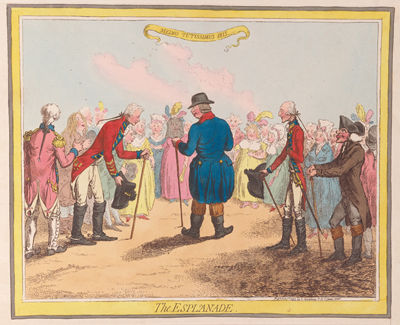The Esplanade
This odd and rather puzzling print shows a splay-footed, silly looking King George III walking on "The Esplanade" surrounded by gawkers and well-wishers—mostly women. The central woman in front of the King, however, is uniquely (and perhaps somewhat ominously) wearing a veil. In the foreground, on his left side, are two army officers. The bowing officer to whom the King turns has been identified by Wright and Evans as Earl Cathcart who appears later in another Gillray print, A Military Sketch of a Gilt Stick, or Poker Emblazoned (1800). On the right of the King, balancing the composition are two other men: a military officer identified as General David Dundas and an unidentified professional man, perhaps a doctor. A banner hovers over the whole scene with a latin quotation from Ovid's Metamorphoses "Medio Tutissimus Ibis" meaning "The safest course is through the middle."

© Beinecke Rare Book and Manuscript Library, Yale University
"The Esplanade" referred to in the print is presumably the so-named public walkway along the waterfront in Weymouth where the King and his family often spent part of their summers after 1789. But the print is dated June 1st, 1797 and the Royal Family did not reach Weymouth until July 31st of that year. Is that a mistake? We know that both Cathcart and Dundas were in fact in Weymouth for the King's arrival. The London Observer for August 6th, for instance, reported that on the previous Monday
Their Majesties and the Princesses walked on the Esplanade till seven o'clock, which was promenaded by a numerous company of Nobility, among whom were—the Earl of Uxbridge and family; Earl and Countess of Harrington; Ladies Cathcart, Pitt, Charlotte Bruce, and Caroline Waldegrave; Lords Cathcart, and Berkeley; Generals Manners, Dundas, and Lascelles; Colonel Garth; Sir H. Neale, and Sir C. Hamilton; with a vast assemblage of spectators from adjacent parts of the country. [My emphasis.]
A few weeks later, the two military veterans participated in a "sham fight" (according to the August 28 London Star) as part of the King's review of his troops.
But if the print is intended merely to record (or purport to record) a possible Weymouth incident, why arrange the figures as Gillray does and include the Latin banner as a kind of heading? The quotation from Ovid derives from the story of Phaeton who wished to drive his father's, the sun god's chariot. Unable to dissuade his son from the attempt, Phoebus advises his son to pursue a middle course:
If you go too high, you'll burn up heaven's roof,
and if too low, the earth. The safest course
to take is through the middle.
In this case, the safest course for the King may be through the middle not because he is flanked by dangerous alternatives, but quite the opposite, because both Cathcart and Dundas were experienced and decorated soldiers who could protect him from potential dangers.
Attacks on the King's life had been made in 1790, 1794, and 1795. And an attempted invasion by the French had been thwarted in December 1796 and even more recently in February, 1797. A huge barracks had been constructed in Weymouth around the same time. In May 1797 there had been mutinies at Nore and Spithead, and while George was still vacationing in Weymouth in August, he received news of uprisings in Scotland to protest the extension of the Militia Bill to that country. It was a perilous time for both the country and its sovereign.
The two soldiers at the King's side had both served with distinction in Holland in 1794-5, Cathcart under the direction of Dundas. Dundas had recently (February 1797) been promoted to the rank of lieutenant-general in recognition of his role in reforming the army. But Cathcart, as may be suggested in the print, ultimately got the better of his former boss. On August 12, while George was still in Weymouth, Cathcart was made Colonel of the 2nd Regiment of Life Guards, the troops specifically charged with the protection of the King and even further was named "Gold Stick," the King's personal ceremonial bodyguard.
Of course all of this makes more sense if the The Esplanade was published not on June 1st, as appears on the print, but (as I suspect) after August 12th when the King was in Weymouth and Cathcart's promotion had been announced. But if we assume that, we introduce a new puzzle: why does the print contain the earlier publication date?
Sources and Reading
- Commentary from the British Museum on The Esplanade.
- "William Cathcart, 1st Earl Cathcart," Wikipedia
- "David Dundas (British Army officer)," Wikipedia
- "George III of the United Kingdom)," Wikipedia
- Thomas Wright and R.H. Evans, Historical and Descriptive Account of the Caricatures of James Gillray #177
- Thomas Wright and Joseph Grego, The Works of James Gillray, the Caricaturist; With the History of His Life and Times, p. 226
Comments & Corrections
NOTE: Comments and/or corrections are always appreciated. To make that easier, I have included a form below that you can use. I promise never to share any of the info provided without your express permission.